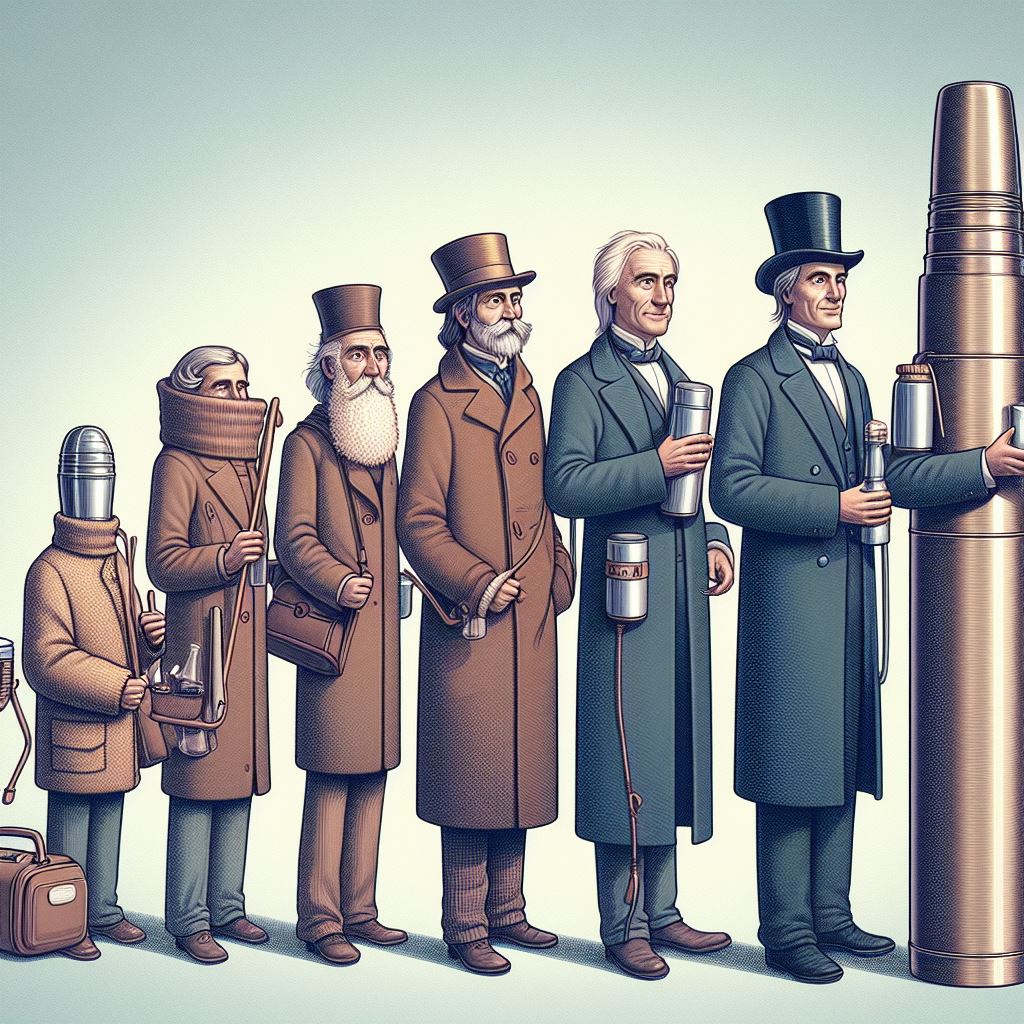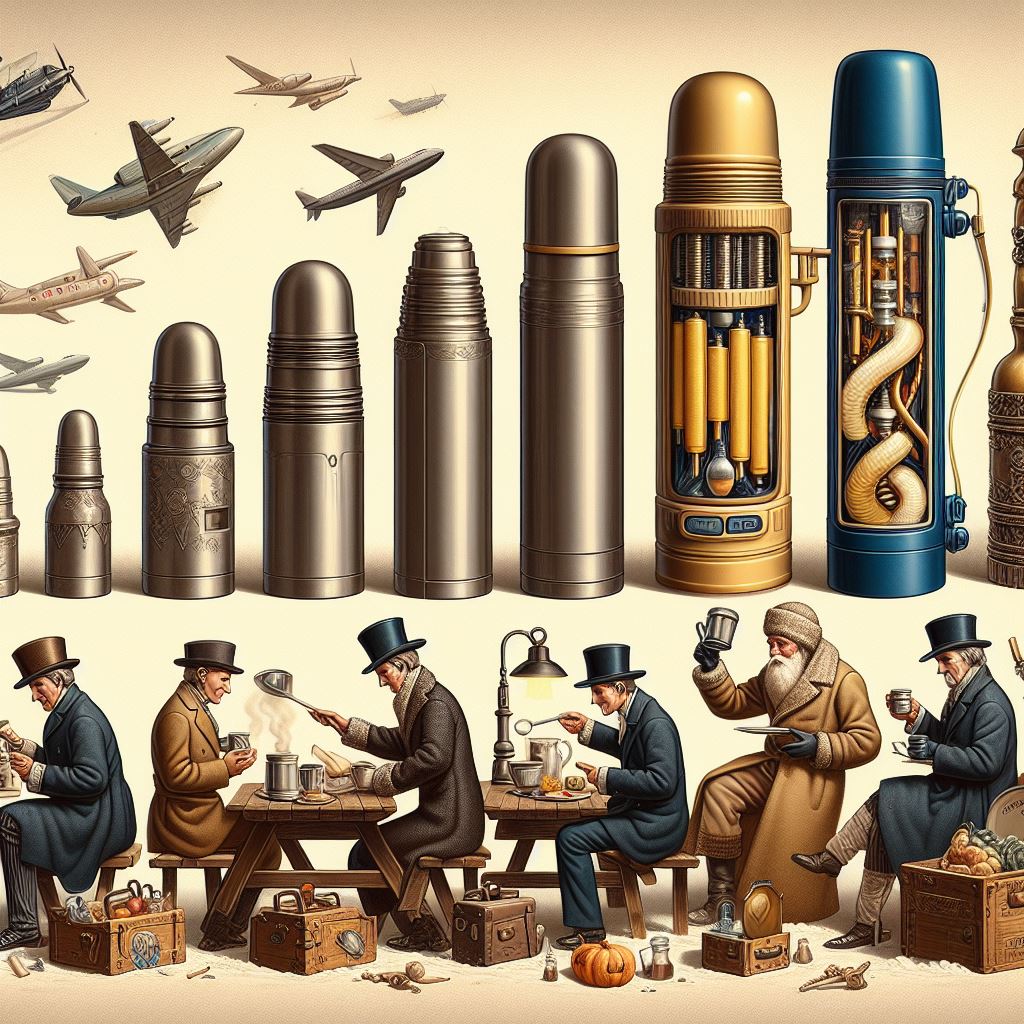The evolution of the thermos from its early inventions to modern-day innovations represents a remarkable journey of scientific discovery, practical application, and cultural integration. This article delves into the history of the thermos, exploring how Sir James Dewar’s groundbreaking vacuum flask invention in 1892 paved the way for a series of advancements that have continually improved our ability to keep drinks hot or cold over extended periods.

The Birth of the Vacuum Flask
The story of the thermos begins with Sir James Dewar, a scientist whose invention of the vacuum flask in the late 19th century revolutionized the way we store and transport temperature-sensitive liquids. Initially designed for laboratory use, Dewar’s flask utilized vacuum insulation—a method that significantly reduces heat transfer by conduction or convection—to maintain the temperature of its contents.
The Thermos Takes Shape: Early 20th Century
The transition of the vacuum flask from a scientific apparatus to a household item is a testament to the invention’s versatility and practicality. Commercialization efforts in the early 20th century introduced the thermos to the wider public, branding it as an essential tool for preserving the temperature of drinks and foods. This period saw significant enhancements in design, including the introduction of more durable materials and user-friendly features that made the thermos a staple in households worldwide.
Mid-Century Innovations and Expansion
The mid-20th century marked a period of diversification for the thermos. Manufacturers experimented with different materials, such as glass, plastic, and stainless steel, to enhance the thermos’s durability and insulation capabilities. The rise of portable convenience also saw the thermos becoming an indispensable accessory for outdoor activities, work, and travel, reflecting the changing lifestyles of the time.

Modern Advances in Thermos Technology
Recent advancements in thermos technology have focused on improving insulation techniques and incorporating smart features. Breakthroughs in materials science have led to the development of thermoses that can keep contents hot or cold for even longer periods, while smart thermoses with connectivity features offer users the convenience of temperature control and monitoring through their smartphones.
Environmental Impact and Sustainability
The environmental impact and sustainability of product design have become increasingly important in recent years. Thermoses, with their reusable nature, play a crucial role in reducing waste associated with disposable beverage containers. By utilizing eco-friendly materials and focusing on durability, manufacturers are ensuring that thermoses not only serve their practical purpose but also contribute to a more sustainable world. The emphasis on reusability highlights the thermos’s role in promoting environmental consciousness, encouraging consumers to make more sustainable choices in their daily lives.
The Cultural Significance of the Thermos
The thermos has transcended its original utility to become a cultural icon in various contexts. In the great outdoors and at workplaces, thermoses symbolize preparedness and the comfort of home, allowing people to enjoy hot or cold beverages regardless of their location. Furthermore, the thermos has made its mark in popular culture, appearing in movies, books, and as a staple in family picnics, reinforcing its status as a beloved item that connects generations.
Looking Ahead: The Future of Thermos Technology
As we look to the future, the potential for innovation in thermos technology is boundless. Emerging trends, such as the integration of smart technology with personal care items, suggest that the next generation of thermoses could offer even more sophisticated features, including automatic temperature adjustment, digital monitoring of contents, and even the ability to brew coffee or tea on the go. Sustainability will remain a key focus, with ongoing research into more eco-friendly materials and designs that further reduce the environmental impact of these indispensable products.

FAQs
- How does a thermos work to keep liquids hot or cold? A thermos maintains the temperature of its contents by using vacuum insulation. This involves a double-walled container with the air removed from between the walls, minimizing heat transfer by conduction or convection.
- Can you microwave a thermos? Most thermoses, especially those made of metal or with vacuum insulation, are not microwave-safe. Always check the manufacturer’s guidelines before attempting to microwave any part of a thermos.
- How long can a thermos keep drinks hot or cold? The duration can vary widely based on the design and material of the thermos. Modern high-quality thermoses can keep drinks hot for up to 24 hours and cold for up to 48 hours or more.
- Is it safe to keep dairy products in a thermos? Yes, it is safe to store dairy products in a thermos temporarily, as long as the thermos is cleaned properly before and after use. However, to prevent bacterial growth, it’s crucial not to leave dairy products in a thermos for extended periods, especially in warm environments.
- Can a thermos lose its vacuum? Yes, a thermos can lose its vacuum seal if it is damaged, which would significantly reduce its insulating effectiveness. Signs of a lost vacuum include the outer surface becoming hot or cold depending on the contents, indicating heat transfer through the walls.
- How can I clean and maintain my thermos to ensure its longevity? Regular cleaning with warm soapy water is recommended. For tough stains or odors, using a mixture of baking soda and water or vinegar can be effective. Avoid using abrasive cleaners or brushes that can damage the interior lining.
Conclusion
The evolution of the thermos from its early inventions to modern-day innovations showcases a journey of ingenuity, adaptability, and sustainability. As we continue to explore and integrate new technologies, the thermos remains a testament to the enduring human desire to improve our quality of life through practical and innovative solutions. Whether it’s keeping our coffee hot on a long commute or ensuring our water stays cold during a hike, the thermos is a constant companion that blends seamlessly into our daily routines, all the while contributing to a more sustainable and environmentally conscious world.